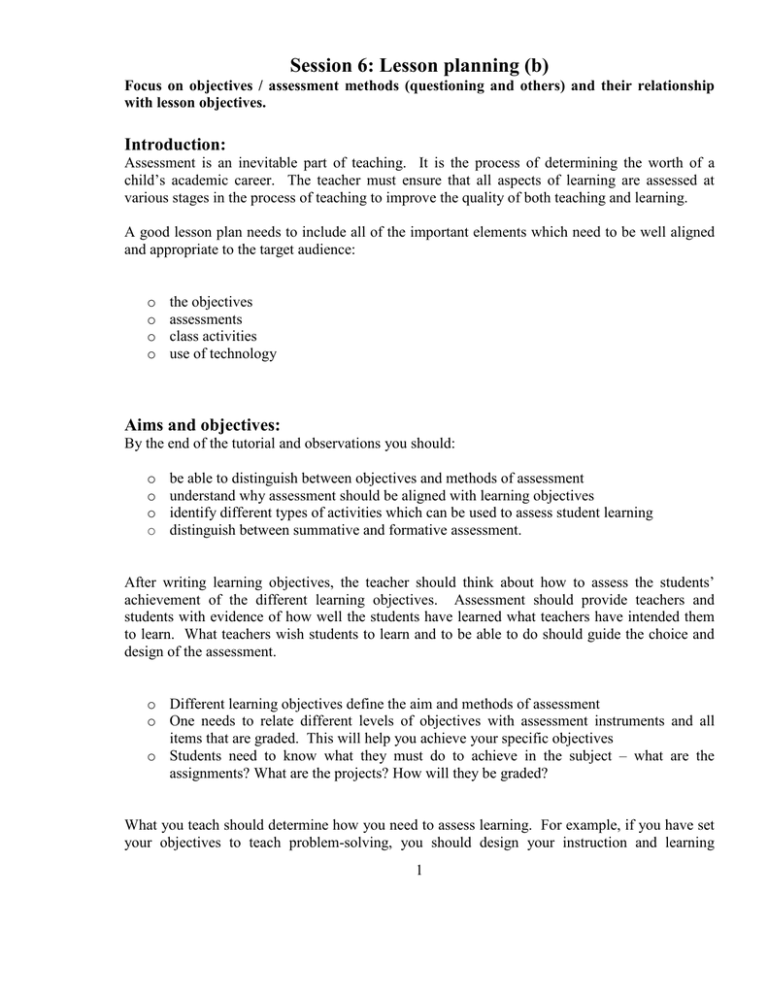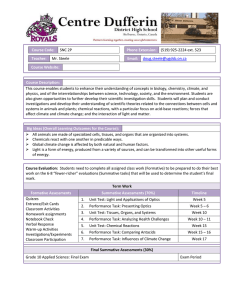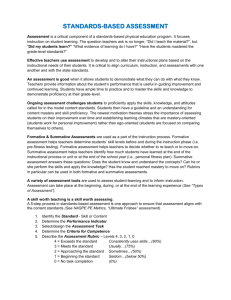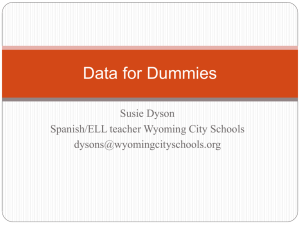Session 6: Lesson planning (b)
advertisement

Session 6: Lesson planning (b) Focus on objectives / assessment methods (questioning and others) and their relationship with lesson objectives. Introduction: Assessment is an inevitable part of teaching. It is the process of determining the worth of a child’s academic career. The teacher must ensure that all aspects of learning are assessed at various stages in the process of teaching to improve the quality of both teaching and learning. A good lesson plan needs to include all of the important elements which need to be well aligned and appropriate to the target audience: o o o o the objectives assessments class activities use of technology Aims and objectives: By the end of the tutorial and observations you should: o o o o be able to distinguish between objectives and methods of assessment understand why assessment should be aligned with learning objectives identify different types of activities which can be used to assess student learning distinguish between summative and formative assessment. After writing learning objectives, the teacher should think about how to assess the students’ achievement of the different learning objectives. Assessment should provide teachers and students with evidence of how well the students have learned what teachers have intended them to learn. What teachers wish students to learn and to be able to do should guide the choice and design of the assessment. o Different learning objectives define the aim and methods of assessment o One needs to relate different levels of objectives with assessment instruments and all items that are graded. This will help you achieve your specific objectives o Students need to know what they must do to achieve in the subject – what are the assignments? What are the projects? How will they be graded? What you teach should determine how you need to assess learning. For example, if you have set your objectives to teach problem-solving, you should design your instruction and learning 1 activities to teach or demonstrate problem-solving, and you should assess the students at problem-solving level. This will make sure you are measuring what you are teaching. There are two major reasons for aligning assessments with learning objectives: o Alignment increases the probability that you will provide students with the opportunities to learn and practise the knowledge and skills that will be required on the various assessments teachers design. o When assessments and objectives are aligned, ‘good grades’ are more likely to translate into ‘good learning’. When objectives and assessments are misaligned, many students will focus their efforts on activities that will lead to good grades on assessments, rather than focusing their efforts on learning what teachers believe is important. Tutorial activity 1: Ask your collaborating teacher to give you a list of five instructional objectives, across different subjects, which she has set for her / students during one particular week. Decide on how to best assess this learning, aligning this assessment with each specific objective. There are many different types of activities that can be used to assess students’ proficiency on a given learning objective, and the same activity can be used to assess different objectives. To ensure accurate assessment of student proficiencies, it is recommended that you use different kinds of activities so that students have multiple ways to practise and demonstrate their knowledge and skills. Learning goals can be assessed through: o o o o o o o o Independently performed worksheets Cooperative learning activities Hands-on experiments Oral discussion Question-and-answer sessions Illustrations or graphic organizers Quizzes Tests It is important to ensure that the assessment activity is directly and explicitly tied to the stated learning objectives. Student performance informs future lessons and where you will take your students next. When deciding on what kind of asessment activities to use, it is helpful to keep in mind the following questions: o What will the students’ work on the activity tell the teacher about their level of competence on the targeted learning objectives? 2 o How will my assessment of their work help guide students’ practice and improve the quality of their work? o How will the assessment outcomes for the class guide the teaching practice? The following table presents examples of the kinds of activities that can be used to assess different types of learning objectives, and the ways that teachers can analyse or measure performance to produce useful feedback for teaching and learning. The categorisation of learning objectives is taken from the revised Bloom’s Taxonomy. Type of Learning Objective Remember Students will be able to: o o recall recognize Understand Students will be able to: o o o o o o o interpret exemplify classify summarize infer compare explain Apply Students will be able to: o o execute implement Analyze Students will be able to: o o o differentiate organize attribute Evaluate Students will be able to: o check Examples of Types of Assessment Objective Test items that require students to recall or recognize information: Fill-in the Blank Multiple Choice items with question stems such as, “what is a…”, or “which of the following is the definition of” Labelling diagrams Reciting (orally, musically, or in writing) Papers, oral/written exam questions, problems, class discussions, concept maps, homework assignments that require (oral or written): Summarizing readings, films, speeches, etc. Comparing and/or contrasting two or more theories, events, processes, etc. Classifying or categorizing cases, elements, events, etc., using established criteria Paraphrasing documents or speeches Finding or identifying examples or illustrations of a concept, principle Activities that require students to use procedures to solve or complete familiar or unfamiliar tasks; may also require students to determine which procedure(s) are most appropriate for a given task. Activities include: Problem sets, performances, labs, Prototyping, Simulations Activities that require students to discriminate or select relevant from irrelevant parts, determine how elements function together, or determine bias, values or underlying intent in presented materials. These might include: Case studies, Critiques, Labs, Papers, Projects, Debates, Concept Maps, A range of activities that require students to test, monitor, judge or critique readings, performances, or products against established criteria or standards. These activities might include: Journals, Diaries, Critiques, Problem Sets, Product Reviews, Case Studies. 3 o critique Create Students will be able to: o o o generate plan produce Research projects, musical compositions, performances, essays, business plans, website designs, prototyping, set designs Table adapted from: http://www.cmu.edu/teaching/assessment/howto/basics/objectives.html Once the students have completed the given assessment activity, take some time to reflect upon the results. Ask yourself whether the learning objectives were achieved adequately. If not, you will need to revisit the lesson in a different manner. Therefore, it is important to assess the final outcome of the lesson and to what extent the final objectives were achieved. Assessment is not separate from the interaction that takes place in a normal classroom situation. Rather, it is an integral and vital aspect of the teaching - learning process and the teacher is the key person in the curriculum implementation process. Assessment can be seen as the process of investigating the status or standard of learners’ attainment, with respect to extended outcomes that must have been specified as objectives. School-based assessment leads to a teacher’s self-assessment of her / his techniques or methods from time to time. This can lead to great improvement in the teaching methods. The teacher can also get feedback about her / his teaching and discover the strategies that will help in achieving the desired goals. There are two main types of assessment: summative and formative. Summative assessment – this is carried out at the end of the course or term; it is used to determine how much the set goals are achieved. It is also referred to as assessment of learning. Formative assessment – this occurs in the classroom. It is sometimes referred to as educational assessment or assessment for learning. It is used in the course of teaching to collect feedback early and often on how well pupils are learning. The purpose is to provide the teacher and pupils with information and insights needed to improve teaching effectiveness and learning quality. It is also referred to as assessment for learning. Tutorial activity 2: During the tutorial, brainstorm and come up with a list of activities / tasks which can be used for assessment. Divide them into two groups – those which are summative and those which are formative. 4 Observation session: Take note of all the identifiable objectives which you can observe throughout the days. Then note in which ways, if any, the teacher assesses these objectives. Compile two lists. Post-observation session: In your tutorial group discuss: o Were the objectives easily identified? o Were these objectives fappropriate for the level of ability / competence of the students concerned? o Were these objectives assessed in an effective manner? 5



